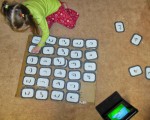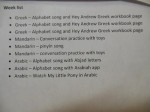I am not an expert in foreign language instruction. I only speak English fluently and have taken upon myself the task of helping my children learn multiple foreign languages. In graduate school for Speech-Language Pathology I was blessed to be able to “specialize” and work with a professor to help international college students reduce their accent. I really enjoyed working with individuals from around the globe. During my studies I realized that in order to first pronounce something correctly, you need to hear it correctly. Our sound systems are formed during childhood and the ability to hear the differences between sounds diminishes with age.
Obviously the best way to raise a child who can speak another language is to have someone in the home who can fluently speak that language with the child. That isn’t possible for many families. My husband and I only speak English and we didn’t have access to someone who could speak another language from the beginning.
So, if you really want your child to learn a foreign language and you don’t speak it. What can you do?
- You can farm it out. Find a local class or get a tutor to guide the studies. Local universities may be a good place to local an international student who is willing to tutor.
- Learn it along with your child.
- Get a tutor or find a local class and learn it along with your child.
- Early years (Birth-age 3): Play children’s songs in the target language. As your vocabulary grows, use those words in your day to day life.
- Preschool-Early Elementary (Age 4-8): Start with a year or two of “immersion” before using a curriculum. DVDs are a great way to introduce your child to the sound system of another language. You can find DVDs that were made for language learning like Little Pim, but getting children’s shows that are dubbed in your target language is another option. Your child won’t be able to comprehend what is said, but you are building up your child’s ability to speak with less of an accent when formal instruction begins. Have your child watch about 30 minutes of a children’s show that is dubbed in your target language. Do this at least 4-5 times per week. My kids watch foreign language videos during breakfast and lunch.
- Late Elementary-Middle School (Age 9 and up): Start with a formal curriculum, but pair it with DVDs that are dubbed in the target language. Even shows targeted for young children like Dora can be useful for this age. The language is more simplistic and easier to understand.
- High School: If you are starting in high school, it would be difficult to make a great deal of progress unless you are using outside classes or a tutor.
We started our foreign language journey when my oldest was in preschool. I had purchased Muzzy in Mandarin. That was a waste of money! Watching Dora or Bob the Builder in Mandarin would have been a much better choice.
When my oldest child was 6 and my younger son was 4, we started our journey toward learning multiple languages. I had considered staggering them, but didn’t want to miss out on the benefits of starting young. We took it slow and have made steady progress through the years.
My oldest child is now in 6th grade and is studying ancient Greek, Mandarin, Arabic, and French. My other children are studying ancient Greek, Mandarin, and Arabic. I postponed starting formal French until 5th grade with only exposure prior to that.
We have made slow and steady progress. My oldest is able to read and write in Arabic now, but has limited vocabulary and conversational skills. Mandarin is also progressing with learning to read, write, and speak. We have recently started using a tutor for conversational skills and to make sure pronunciation is on track. Ancient Greek is progressing with being able to read and write in Greek. We are digging deep into the grammar and learning more vocabulary now. French started in 5th grade and we first had to tackle pronunciation, but didn’t need to spend much time learning to read and write it. In our second year of French we are learning vocabulary and conversational skills. We still have a long ways to go in all of the languages.
I don’t expect that we will be able to reach fluency, but my child can choose to study the language further in university. I do expect that my children will be able to successfully communicate with Mandarin, Arabic, and French speakers and be able to read and understand the Bible in ancient Greek. I also expect that my children will better understand the Chinese, French, and Arab cultures.
We spend about 30-40 minutes each day watching DVDs in a foreign language and our formal foreign language studies are about 60-90 minutes per day. My youngest child is in Kindergarten and spends far less time in formal studies, but she does watch 30-40 minutes of DVDs.
A typical week for my 6th grader might include:
- 30 minutes of formal French studies 3-4 times per week. He uses a college French textbook because it is easier for me to use and it has plenty of audio support. Also, used college texts are cheap! Duolingo is used instead of his textbook about once per week.
- 30 minutes of formal Arabic studies 3-4 times per week. He is using a college Arabic textbook.
- 30 minutes of formal Mandarin studies 3-4 times per week. He is using a college Mandarin textbook and we go over the information the tutor gave us.
- 30 minutes of formal Greek studies about 3 times per week. He is using Athenaze, a high school textbook. Sometimes he does game-based vocabulary exercises with his brother instead of formal study.
- 30 minutes of formal Arabic studies 3-4 times per week. He is using a college Arabic textbook and is learning to read and write all the different letters.
- 30 minutes of formal Mandarin studies 3-4 times per week. He is using a college Mandarin textbook and we go over the information the tutor gave us.
- 30 minutes of formal Greek studies about 3 times per week. He is using Athenaze, a high school textbook. Sometimes he does game-based vocabulary exercises with his brother instead of formal study.
- Playing Arabic games on the iPad to learn the letters and some basic vocabulary. We also watch Youtube alphabet songs. She does this for 20-30 minutes about 3 times per week. Prior to this school year she had a couple years of exposure through DVDs and exposure to the alphabet song from toddlerhood.
- Practicing Mandarin conversation with me “making her toys talk”. We also watch a pinyin video on Youtube that helps her learn the names of the letters in pinyin and say the tones correctly. She also has iPad games. She does this for 20-30 minutes 2-3 times per week. Prior to this school year she had about 4 years of exposure and grew up loving Mandarin videos.
- Koine Greek is a new one this year. She sings the alphabet song (preferably upside down in my arms so I can “smell” her feet) and then does a page or part of a page in the Hey Andrew Teach Me Some Greek workbook. This probably takes about 10 minutes 3 times per week.
So how do you teach a foreign language when you don’t speak it? You don’t. You can’t teach something you don’t know, but you can learn with your child and guide his studies. My oldest child has skills beyond my own, but I can still guide his studies and practice conversation with him. I just have the book open when I do it. I’m learning and they are learning. It isn’t ideal, but it is working. They are making progress and I am making progress.
If you are interested in the names of the textbooks or resources we are using, click here to see the page that lists our curriculum choices. I’ve listed and linked to the different resources there. If you have any questions or if anything I said was unclear, please leave a comment and I will do my best to respond.







Thank you so much for this series on foreign languages! It’s amazingly helpful. I’m a foreign language nerd, enthusiast, and student of multiple languages, in addition to being bilingual (English/Arabic both native) and now a new homeschooling mom who is trying to wrap her head around how best to teach her little ones foreign languages. I know what works for me (I echo your sentiments that long-term exposure and immersion to verbal should always precede focused study to develop an ear for the rhythm and sounds of the language), so I will adapt and observe and see their preferences/learning styles. Your posts on schedule, resources, different approaches is really helping me navigate all of this. Please don’t ever stop doing what you do. I love all of your ideas on homeschooling.
Caryn, thank you so much for this wonderful resource! I’ll be checking this out right away.
Have a 2 year old. Languages – English (native), Mandarin, French Hungarian. Language time looks like this:
Every morning – read a book in French
Every night – Chinese book read by Mummy (I have to memorise the characters in the book as I only read pinyin well)
Three nights a week – bathtime with Grandma in Hungarian
Twice a week (2 1/2 hrs) – free playtime with Chinese native speaker. Adults not allowed to speak English.
Regularly – songs, poems in all languages and random vocab recapping led by baby.
Predictably, English and Mandarin much better than French and Hungarian. Can make sentences in first two languages. Baby is fascinated by languages and wants to start Korean (help!!!!!!!!), but I might have to say no for now . . . (doesn’t that feel terrible?)
We use pimsleur arabic (levant) for fluency. We actually live in an Arabic speaking country now. Pimsleur has been very helpful to us. My 5 year old oicks up some ohrases from the neighbors that I tutor in English and doesnt like to repeat the “listen and repeat” exercises. But he is still absorbing the vocabulary in sentence/conversation context with proper pronunciation. We are still illiterate mainly, but working on it slowly. The level 2 and 3 pqcks can be obtained rather inexpensively over the internet as well.
I’m a homeschool mom of 4 from Raleigh, NC, and we are in our 11th year of homeschooling. I’m also a Spanish teacher with 10 years of public school classroom experience. I’d love for you to check out my Spanish curriculum, designed especially for homeschoolers! We use TPR and storytelling approaches to achieve real fluency. It’s great for multiple ages, and it’s very user-friendly, with video lessons on DVD that the whole family can use at the same time. I hope it blesses you! http://www.exceleratespanish.com
Thanks Caryn! Your program does sound like it would be a great choice for Spanish. However, Spanish isn’t one of the languages we are studying. We are learning French, Arabic, Mandarin, and ancient Greek.